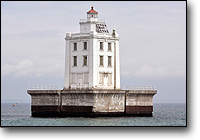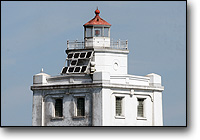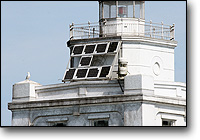|
Historical Information

With less than a foot of water covering the rocky bottom of its
shallowest point, Martin Reef lurked menacingly offshore to the east of
Les Cheneaux Islands, approximately seven miles east southeast of
Cedarville, and had long represented a significant hazard for maritime
traffic threading its way between the Straits of Mackinac and the
entrance to the DeTour Passage.
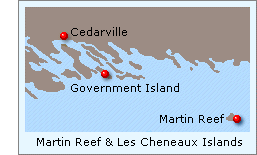 With
maritime traffic through the area increasing dramatically toward the end
of the nineteenth century as a result of the discovery of inexpensive ore
along Superior's north shore and the resulting rapid proliferation of
steel mills at Chicago, Milwaukee and Joliet, the Lighthouse Board
evaluated various aids to navigation at the reef to increase the safety
of mariners passing through the area. With the realization that the cost
of a permanent station would be prohibitive, in its annual report for
1896 the Board recommended that $15,000 be appropriated for the
construction of a wooden lightship to be placed on Martin Reef. While
Congress was unresponsive to the request, the Board remained convinced
of the need to light the reef, and reiterated its request in its reports
for the following three years. In fact, in its 1900 report the Board
increased the amount of its request to $35,000 after realizing that the
reef's exposed location at the northern end of Lake Huron would subject
the vessel to the full fury of wave action building up along the entire
length of the lake, and that a steel-hulled vessel would better suit
such an exposed location. Congress continued to ignore the Board's
repeated annual requests for the vessel until June 20, 1906 when an act
was finally passed authorizing a contract for the construction of a
vessel at a total cost not to exceed $45,000, with a partial
appropriation of $25,000 for the work approved ten days later. With
maritime traffic through the area increasing dramatically toward the end
of the nineteenth century as a result of the discovery of inexpensive ore
along Superior's north shore and the resulting rapid proliferation of
steel mills at Chicago, Milwaukee and Joliet, the Lighthouse Board
evaluated various aids to navigation at the reef to increase the safety
of mariners passing through the area. With the realization that the cost
of a permanent station would be prohibitive, in its annual report for
1896 the Board recommended that $15,000 be appropriated for the
construction of a wooden lightship to be placed on Martin Reef. While
Congress was unresponsive to the request, the Board remained convinced
of the need to light the reef, and reiterated its request in its reports
for the following three years. In fact, in its 1900 report the Board
increased the amount of its request to $35,000 after realizing that the
reef's exposed location at the northern end of Lake Huron would subject
the vessel to the full fury of wave action building up along the entire
length of the lake, and that a steel-hulled vessel would better suit
such an exposed location. Congress continued to ignore the Board's
repeated annual requests for the vessel until June 20, 1906 when an act
was finally passed authorizing a contract for the construction of a
vessel at a total cost not to exceed $45,000, with a partial
appropriation of $25,000 for the work approved ten days later.
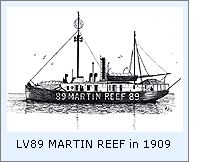 Plans
drawn-up by the engineers at the Detroit depot for what was to be
designated as LV89 called for a vessel of unique design, featuring a
whaleback forecastle deck designed to easily shed water as she rode at
anchor. After submitting the lowest bid, the Racine-Truscott-Shell Boat
building Company of Muskegon was awarded the contract for the vessel's
construction, and work on the hull began in the spring of 1907. She was
to be 88' 3" in length, her hull 21' in beam and her draft 7'.
While her single cylinder steam reciprocating engine with 17" bore
and 16" stoke would not afford her great speed, it was more than
sufficient to allow her to get on and off station under her own power.
Her single mast, mounted forward allowed her cluster of three
oil-powered lens-lanterns to be raised to a focal plane of 35 feet, and
her six-inch steam whistle would allow her to announce her presence in
thick weather. With her hull painted a bright red, and "89 MARTIN
REEF 89" emblazoned in large white letters on each side, she was
completed in the fall of 1908, and officially delivered to Eleventh
District Inspector Commander James T. Smith in October of that year. As
a result of her delivery so late in the season she was docked in
Cheboygan through the winter, and was not placed in her position one
mile south of the reef until the opening of the 1909 season of
navigation. Plans
drawn-up by the engineers at the Detroit depot for what was to be
designated as LV89 called for a vessel of unique design, featuring a
whaleback forecastle deck designed to easily shed water as she rode at
anchor. After submitting the lowest bid, the Racine-Truscott-Shell Boat
building Company of Muskegon was awarded the contract for the vessel's
construction, and work on the hull began in the spring of 1907. She was
to be 88' 3" in length, her hull 21' in beam and her draft 7'.
While her single cylinder steam reciprocating engine with 17" bore
and 16" stoke would not afford her great speed, it was more than
sufficient to allow her to get on and off station under her own power.
Her single mast, mounted forward allowed her cluster of three
oil-powered lens-lanterns to be raised to a focal plane of 35 feet, and
her six-inch steam whistle would allow her to announce her presence in
thick weather. With her hull painted a bright red, and "89 MARTIN
REEF 89" emblazoned in large white letters on each side, she was
completed in the fall of 1908, and officially delivered to Eleventh
District Inspector Commander James T. Smith in October of that year. As
a result of her delivery so late in the season she was docked in
Cheboygan through the winter, and was not placed in her position one
mile south of the reef until the opening of the 1909 season of
navigation.
With the size and strength of
commercial vessels increasing through the 1920's, the season of
navigation was beginning earlier in the year as these larger vessels
were able to make their way through some of the thicker ice impenetrable
to smaller vessels under their own power. However, with pack ice around
Martin Reef frequently remaining in place late into the year, and with
her diminutive size and power, LV89 was frequently unable to make her
way into position on the reef until a considerable number of vessels had
already made their way through the area.
To this end, the engineers of the
United States Lighthouse Service began working on a design for a
permanent light for Martin Reef, to allow the station's keepers to gain
access to the station earlier in the season using a smaller boat which
could by carried across the thicker ice.
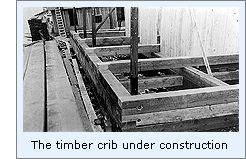 With Congressional approval for the
construction of the new station, the first order of business was the
establishment of a land-based camp as close as possible to the reef.
Here, the cribs and concrete forms could be constructed and the 18-man
crew could be housed until work progressed sufficiently to allow the
establishment of quarters on the reef itself. By the twin virtues of
having deep water close to its shore and its proximity to the
construction site, Scammon's Harbor on the north shore of Government
Island in Les Cheneaux Islands was selected as the best location for the
base camp. This was not the first time that Scammon's Harbor had been
used for such an operation, as the base camp for the Spectacle Reef
project had been located there some fifty years previous, and the island
on which the harbor was located had received it's name as a result of
the Government's use of the island at that time. With Congressional approval for the
construction of the new station, the first order of business was the
establishment of a land-based camp as close as possible to the reef.
Here, the cribs and concrete forms could be constructed and the 18-man
crew could be housed until work progressed sufficiently to allow the
establishment of quarters on the reef itself. By the twin virtues of
having deep water close to its shore and its proximity to the
construction site, Scammon's Harbor on the north shore of Government
Island in Les Cheneaux Islands was selected as the best location for the
base camp. This was not the first time that Scammon's Harbor had been
used for such an operation, as the base camp for the Spectacle Reef
project had been located there some fifty years previous, and the island
on which the harbor was located had received it's name as a result of
the Government's use of the island at that time.
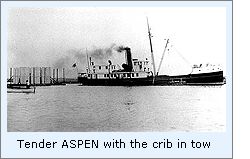 With the establishment of the base
camp, work began simultaneously at both Scammon's Harbor and Martin
Reef. At camp, the massive 65' square wooden crib was constructed of
12" square oak timbers on a skid-way down which it
would eventually slide into the water. On the reef, hard-hat divers
worked with a scow equipped with a crane system to clear and level an
area in ten feet of water at the southeast end of the reef where the
crib would eventually be placed. With the site on the reef prepared, the
crib was lowered down the greased skid-ways into the water, and the lighthouse tenders MARIGOLD and Aspen attached lines
and carefully guided the huge structure out of the harbor, through the
100-foot channel between the islands and into the open water of Lake
Huron. With the establishment of the base
camp, work began simultaneously at both Scammon's Harbor and Martin
Reef. At camp, the massive 65' square wooden crib was constructed of
12" square oak timbers on a skid-way down which it
would eventually slide into the water. On the reef, hard-hat divers
worked with a scow equipped with a crane system to clear and level an
area in ten feet of water at the southeast end of the reef where the
crib would eventually be placed. With the site on the reef prepared, the
crib was lowered down the greased skid-ways into the water, and the lighthouse tenders MARIGOLD and Aspen attached lines
and carefully guided the huge structure out of the harbor, through the
100-foot channel between the islands and into the open water of Lake
Huron.
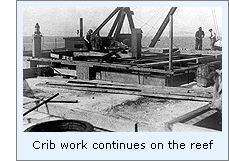 Arriving at Martin Reef, the crib was
carefully centered on the cleared and leveled area, and ballast pockets
built into the crib were filled with crushed limestone delivered by
freighters and transferred into the crib with the assistance of the
scow's conveyor. Eventually overcoming its natural buoyancy, the crib
sank on the prepared bottom. Divers then descended to the bottom of the
crib and filled all gaps between the surface of the reef and the lower
edges of the crib with rope caulking and Portland cement to create a
water-tight seal. With the pockets completely filled, the water was
pumped from the open areas in the crib, prefabricated forms were
attached, and the work of filling the crib with concrete
from a mixer aboard the scow began. As the pour continued, forms for the
four arch-roofed cellar areas for coal and water storage were installed
and cast in place. Arriving at Martin Reef, the crib was
carefully centered on the cleared and leveled area, and ballast pockets
built into the crib were filled with crushed limestone delivered by
freighters and transferred into the crib with the assistance of the
scow's conveyor. Eventually overcoming its natural buoyancy, the crib
sank on the prepared bottom. Divers then descended to the bottom of the
crib and filled all gaps between the surface of the reef and the lower
edges of the crib with rope caulking and Portland cement to create a
water-tight seal. With the pockets completely filled, the water was
pumped from the open areas in the crib, prefabricated forms were
attached, and the work of filling the crib with concrete
from a mixer aboard the scow began. As the pour continued, forms for the
four arch-roofed cellar areas for coal and water storage were installed
and cast in place.
At this stage of the construction, the
work crew continued to spend their nights at Scammon's Harbor, with the
lighthouse tender Aspen transporting them to and from the reef twice
each day. With the pouring of the curved wave apron, work on the crib
was complete and the upper surface of the pier was carefully leveled in
order to create a level foundation for the lighthouse structure itself,
which was to be erected at the exact center of the pier. Completion of
the pier structure also allowed the construction of a bunkhouse on the
reef, and work on the tower progressed quickly since the twice daily
trips transporting the crew between Scammon's Harbor and the reef were
no longer necessary. A temporary light was also installed on the
railing, and with this new light to mark the reef LV89 was no longer
needed at the reef, and was reassigned to North Manitou Shoal in Lake
Michigan.
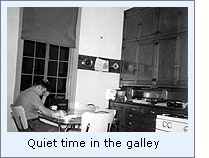 The
twenty-five foot square station structure was designed with
three-stories, its exterior walls of reinforced concrete and iron over a
skeletal steel frame. A stairway
connected each floor and continued above the living quarters into the
centrally located tower. With the lower floor designed as an engine room
for the station's machinery, the second and third floors served as
living areas for the station's keepers. The second floor featured an
office in the northwest corner, a bathroom on the south side, and a
kitchen on the southwest corner, while the third floor was divided into
bedrooms for the head keeper and his assistants. The four concrete rooms
within the crib served as coal and food storage, and water cisterns
contained drinking water that was fed by down spouts from the station's
roof The
twenty-five foot square station structure was designed with
three-stories, its exterior walls of reinforced concrete and iron over a
skeletal steel frame. A stairway
connected each floor and continued above the living quarters into the
centrally located tower. With the lower floor designed as an engine room
for the station's machinery, the second and third floors served as
living areas for the station's keepers. The second floor featured an
office in the northwest corner, a bathroom on the south side, and a
kitchen on the southwest corner, while the third floor was divided into
bedrooms for the head keeper and his assistants. The four concrete rooms
within the crib served as coal and food storage, and water cisterns
contained drinking water that was fed by down spouts from the station's
roof
Atop the center of the main structure,
a ten-foot tall watch room, sixteen feet square was capped with an
octagonal cast iron lantern with vertical astragals. The lantern
contained a flashing white Fourth Order Fresnel lens manufactured by
Sautter & Cie of Paris, and was powered by an 8,000 candlepower lamp
with a characteristic of three flashes every ten seconds. The sixty-five
foot focal plane of the lens created a visibility range of 14 miles
during clear weather. For periods of thick weather, the station was
also outfitted with a compressed air diaphone
fog signal powered by an oil-powered air compressor located in
the first floor equipment room.
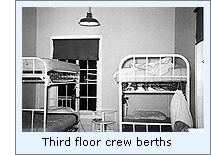 With
construction of the station completed in the summer of 1927, the work
crew loaded the camp buildings and bunkhouse onto the scow and
lighthouse tenders Marigold and Aspen, and
relocated to the Cheboygan pier to begin construction of a duplicate of
the structure at Martin Reef on Poe Reef, off Cheboygan Harbor. With
construction of the station completed in the summer of 1927, the work
crew loaded the camp buildings and bunkhouse onto the scow and
lighthouse tenders Marigold and Aspen, and
relocated to the Cheboygan pier to begin construction of a duplicate of
the structure at Martin Reef on Poe Reef, off Cheboygan Harbor.
With the transfer of responsibility for
the nation's aids to navigation to the Coast Guard in 1939, electrical generators were installed at
the station and an electric
light was installed within the Fourth Order lens. Under the Coast Guard,
the station was manned by four-man crews consisting of a Chief
Engineman, Boatswain's Mate, a Fireman and a Seaman.
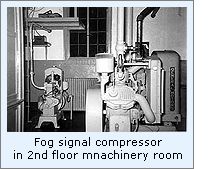 The station would usually be opened for
the season of navigation around the beginning of April, and the crew
would assemble at the Cheboygan Coast Guard station where they would
purchase their initial supplies at a local grocery store. A Coast Guard
180' foot boat would then push its way through the ice to deliver the
men at the reef. On arrival at the station it was frequently caked in
ice, sometimes reaching as high as the third floor, and the first order
of business was to chip away around the door to gain entry. The station
was heated by an oil-fired furnace in one of the "dungeons,"
as the four storage areas within the crib were irreverently called by
the crews. This furnace fed the rooms through ducts which were located
throughout the structure. Once the furnace was operating, the
temperature warmed to a comfortable level, however the coldness of the
structure itself caused the walls to sweat for the first three or four
weeks every year. Electrical power was provided by a bank of DC
batteries that were charged by a pair of duplicate GM 271 twin-cylinder
generators. Living conditions at the station
provided as much comfort as such cramped conditions could afford, and the men
quickly settled into the daily routine of cleaning, painting and
equipment maintenance. The station would usually be opened for
the season of navigation around the beginning of April, and the crew
would assemble at the Cheboygan Coast Guard station where they would
purchase their initial supplies at a local grocery store. A Coast Guard
180' foot boat would then push its way through the ice to deliver the
men at the reef. On arrival at the station it was frequently caked in
ice, sometimes reaching as high as the third floor, and the first order
of business was to chip away around the door to gain entry. The station
was heated by an oil-fired furnace in one of the "dungeons,"
as the four storage areas within the crib were irreverently called by
the crews. This furnace fed the rooms through ducts which were located
throughout the structure. Once the furnace was operating, the
temperature warmed to a comfortable level, however the coldness of the
structure itself caused the walls to sweat for the first three or four
weeks every year. Electrical power was provided by a bank of DC
batteries that were charged by a pair of duplicate GM 271 twin-cylinder
generators. Living conditions at the station
provided as much comfort as such cramped conditions could afford, and the men
quickly settled into the daily routine of cleaning, painting and
equipment maintenance.
Cooking was done on a propane-powered
stove, and meals usually consisted of a lunch of soup and sandwiches,
with a large supper served in the evening which everybody who was
considered capable would help prepare. While the station was outfitted
with a television set in the 1950's, for some reason the location of the
station only afforded a selection of a couple of French language
stations! Jack Stiehl recalls some of the men building plastic ship
models as a diversion, launching them in the lake, and then using them for
target practice as they sailed away from the station. One particularly
melancholy recollection of Jacks is looking out the kitchen window,
watching a neon "BEER" sign flashing on the east side of
Cheboygan on clear nights!
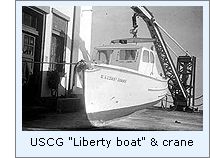 The station was outfitted with a
20'
boat with a cabin that was raised onto the pier by one of the two
deck-mounted cranes. This boat was used by the crew members to run
"liberty parties" to Cheboygan, but the boat was removed in
1959, with transportation to and from shore subsequently provided by the
Coast Guard station at Mackinaw Island. Since Huron's northern offshore
lights were so remotely located, the crews of Poe, Martin and Spectacle
Reef lights conducted a radio check every morning and evening. If any of
the crews missed two consecutive checks, a boat was dispatched from
Cheboygan to check up on them. The station was outfitted with a
20'
boat with a cabin that was raised onto the pier by one of the two
deck-mounted cranes. This boat was used by the crew members to run
"liberty parties" to Cheboygan, but the boat was removed in
1959, with transportation to and from shore subsequently provided by the
Coast Guard station at Mackinaw Island. Since Huron's northern offshore
lights were so remotely located, the crews of Poe, Martin and Spectacle
Reef lights conducted a radio check every morning and evening. If any of
the crews missed two consecutive checks, a boat was dispatched from
Cheboygan to check up on them.
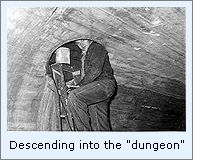 At the end of each season of
navigation, antifreeze was poured into all drains, the window shutters
were closed, and the generating and heating equipment was winterized.
The rack of batteries was left fully charged to provide power for a 200
mm, 110 candlepower light that was left burning throughout the winter to
provide direction for any late vessels making their way along the north
shore. Every year care was taken to ensure that all the food was
consumed by the time the station was closed for the year. However, in
1958 a small private aircraft crashed in north Lake Huron, and the pilot
managed to make his way across the ice to Spectacle Reef Light station.
Entering the station, and finding no food, he left a note and set out
for land. The pilot was never heard from again, and it could only be
assumed that he had perished on the ice. From that point on, the crew at
Martin Reef always made sure that they left a supply of non-perishable
food at the station before departing at the end of each year's
navigation season. At the end of each season of
navigation, antifreeze was poured into all drains, the window shutters
were closed, and the generating and heating equipment was winterized.
The rack of batteries was left fully charged to provide power for a 200
mm, 110 candlepower light that was left burning throughout the winter to
provide direction for any late vessels making their way along the north
shore. Every year care was taken to ensure that all the food was
consumed by the time the station was closed for the year. However, in
1958 a small private aircraft crashed in north Lake Huron, and the pilot
managed to make his way across the ice to Spectacle Reef Light station.
Entering the station, and finding no food, he left a note and set out
for land. The pilot was never heard from again, and it could only be
assumed that he had perished on the ice. From that point on, the crew at
Martin Reef always made sure that they left a supply of non-perishable
food at the station before departing at the end of each year's
navigation season.
On a date which we have as yet been
unable to determine, Martin Reef was automated through the installation
of a solar-powered 200 mm acrylic lens, and the Fourth Order Fresnel was
carefully removed from the tower and shipped to Point Iroquois Light
Station, where it is proudly displayed as part of that station's museum. Martin
Reef light station was offered by the General Services Administarion
via the National Historic Lighthouse Preservation Acti on May 1, 2013.
Hopefully a local non-profit or government entity will
file for ownership and restore the station.
Keepers of
this Light

Click here
to see a complete listing of all Martin Reef Light keepers compiled by
Phyllis L. Tag of Great Lakes Lighthouse Research.
Seeing this Light

Since
it is located out of visibility from shore other than very distant
glimpses while driving along Hwy 134 on the way east to DeTour, for
many years the only way to see the station was from a private or
chartered vessel or aircraft. However, over the last few years, close
up views of Martin Reef Light station can be had on Sheper's Les
Cheneaux cruises which are held a number of times each
summer season. For a schdule, check out the "Lighthouse Cruises" section
of the Shepler's Mackinac Island Ferry website at www.sheplersferry.com
Reference Sources Lightships and Lightship Stations of the United States Government,
Willard Flint, 1989. Martin Reef - Lightship to Lighthouse, John
J. Selleman, 1995.
NOAA Great Lakes Coast Pilot, 2000.
Photograph from US Coast
Guard Historian's Office
Photograph courtesy of Marge Beaver of
Photography Plus
Light-house Board annual reports from 1896 through 1909.
Great Lakes Light Lists, 1928, 1939 & 1953.
10/08/01 email from Joann Gulau with Jack Stiehl's recollections of
Martin Reef.
Photographs courtesy of Jack Stiehl.
Grand Haven Tribune,
August 6, 2000
Keeper listings for this light appear courtesy of Tom & Phyllis Tag
|
